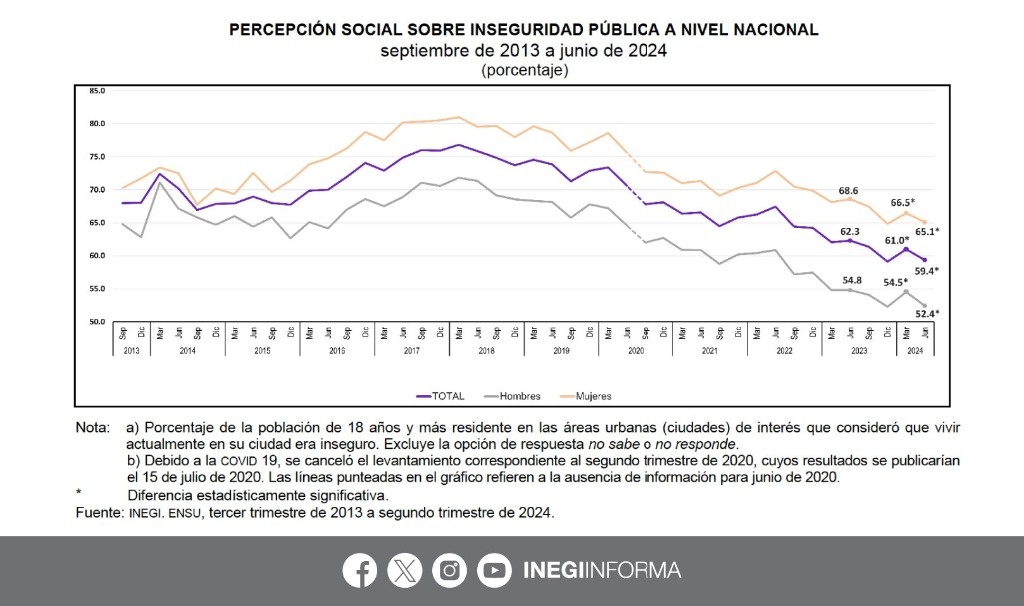Mexico City. Nationally, 59.4 percent of the population aged 18 and over in Mexico considered it unsafe to live in their city. According to the National Institute of Statistics and Geography (INEGI), this represented “a statistically significant change” compared to the percentages of 61 percent in March and 62.3 percent in June 2023.
Following the spike in March, the perception of insecurity among the population aged 18 and over, residing in 90 cities in Mexico, decreased during the electoral period in Mexico (April-June); where 65.1 percent of women and 52.4 percent of men considered it unsafe to live in their city, both also showing decreases.
The urban areas (cities) of interest with the highest percentage of people aged 18 and over who considered living in their city to be unsafe were: Fresnillo, with 94.7 percent; Naucalpan, State of Mexico, 89.2 percent; Uruapan, 86.8 percent; Irapuato, 84.8 percent; Tapachula, 84.7 percent; and Zacatecas, 84.7 percent.
In contrast, the urban areas where the perception of insecurity was lower were: San Pedro Garza García, with a perception of 11.7 percent; Piedras Negras, 14.3 percent; Los Cabos, 16.7 percent; Los Mochis, 18.7 percent; Benito Juárez, 18.9 percent; and Saltillo, 21.4 percent.
Regarding the perception of insecurity in specific physical spaces, in June 2024, 67.9 percent of the population reported feeling unsafe at ATMs located on public roads; 62.7 percent on public transport; 53.7 percent on the road; and 52.9 percent at the bank.
In June 2024, three out of 10 people aged 18 and over, residing in the urban areas (cities) of interest, considered that, in the next 12 months, the crime and insecurity situation in their city will remain just as bad. On the other hand, 18.1 percent of the population reported that the situation will worsen in the next 12 months. In contrast, 18.8 percent of the population aged 18 and over said that the crime and insecurity situation in their urban area will remain just as good and 28.7 percent said that it will improve.
Problems in sightfacing
During the first half of 2024, Inegi estimated that 25.9 percent of households had at least one member who was the victim of at least one crime of total or partial vehicle theft, home robbery, robbery or assault on the street or public transportation (including bank or ATM robbery) or robbery in a manner other than the above or extortion.
The most important problems in their city, 77.7 percent of the population over 18 years of age, stated that they were potholes in streets and avenues; 70.2 percent said that they were faults and leaks in the supply of drinking water and 56.6 percent considered that public lighting was insufficient. Likewise, 48 percent responded that overcrowded hospitals or those with poor service represented one of the biggest problems in their cities.
In response, 44.4 percent of the population aged 18 and over, living in the urban areas (cities) studied, avoided carrying valuables, such as jewelry, money or credit cards, for fear of being involved in a crime. Meanwhile, 39.3 percent changed routines regarding allowing their minor children to leave their homes, 38.8 percent made changes regarding walking around their homes after 8 p.m., and 24.3 percent changed routines related to visiting relatives or friends.
In June 2024, the percentages of the population that identified the various public security authorities and perceived their performance as very or somewhat effective in their work to prevent and combat crime were the Navy, with 86.9 percent; the Army, with 82.9 percent; the Mexican Air Force, with 82.4 percent; the National Guard, with 74.1 percent; state police, with 56.8 percent; and municipal preventive police, with 48.7 percent.
#Perception #insecurity #Mexico #improves #quarter
– 2024-07-31 01:40:02
